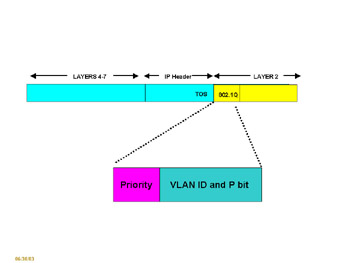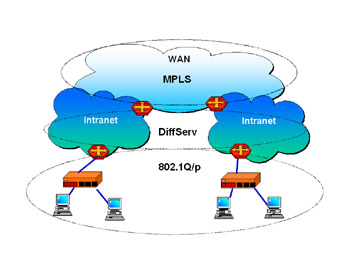Packet Marking
|
| < Day Day Up > |
|
Packet-marking procedures can be broken down into marking, classifying, and policing procedures. Marking protocols, such as 802.1Q/p (Figure 8.7), DiffServ (Figure 8.8) and MPLS (Figure 8.9), are able to sort and mark packets according to pre-established rules.

Figure 8.7: QoS Markings for 802.1Q/p

Figure 8.8: QoS Marked on the Network Layer DiffServ

Figure 8.9: QoS Marked on the MPLS Shim Header
You can think of these protocols as existing on three different levels: 802.1Q/p is a LAN protocol, DiffServ is a MAN protocol, and MPLS is a WAN protocol. 802.1Q/p marks a packet with priority bits in its Layer 2 header; however, this layer does not migrate across a router.
In Figure 8.7, we see that the 802.2Q protocol inserts a new header behind the traditional Ethernet header. Three bits of the 802.1Q header are used to mark packet priority. It is interesting to note that this marking is not routable. So other forms of marking must be used in order to route priority marked packets.
To get the markings across the router, a packet must be marked at Layer 3 or above. DiffServ marks a packet for migration across routers. Figure 8.8 shows DiffServ code points. These are used to carry packet QoS markings in routed environments; however, Diffserv code points are not always used. MPLS works at Layer 2.5; a method must be used to mark packets so that MPLS switches can understand the QoS requirements. MPLS may use three EXP bits to transport QoS markings across an MPLS network as seen in Figure 8.9.
We see in Figure 8.10 that packets are marked at several levels: Layer 2, Layer 2-shim, and Layer 3.

Figure 8.10: Packets Marked in Three Places
Figure 8.11 illustrates how marked packets can give a network designer end-to-end coverage for QoS. Despite markings, these protocols cannot assure instantaneous bandwidth. Think of bumper-to-bumper, rush-hour traffic when an ambulance, with lights flashing and siren blaring, attempts to move through traffic. Despite its markings, the ambulance cannot move.

Figure 8.11: End-to-End QoS Marking
|
| < Day Day Up > |
|
EAN: 2147483647
Pages: 138